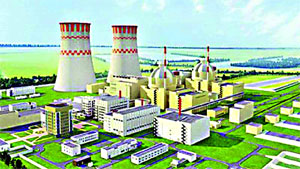A Rahman
Bangladesh is about to embark on Rooppur Nuclear Power Plant (RNPP) project – the largest ever undertaken in this country in terms of cost, technical complexity and risk profile. Instead of going for a single, smaller nuclear power plant and gather experience and expertise, Bangladesh is going flat out foolhardily for two large output (1200 mw – 3,000 mw) plants almost simultaneously at enormous cost.
Recently it has been reported that Bangladesh Atomic Energy Commission (BAEC) on behalf of the Bangladesh Government and the Atomstroyexport on behalf of the Russian Government have signed contracts whereby Russia will provide 90 percent of the anticipated cost of $12.65 billion for the construction of these two reactors at Rooppur, Pabna.
Mega ‘cost plus’ contract
The Nuclear Power Company of Bangladesh (NPCB) had been set up under the Nuclear Power Plant Act 2015 to run the plant, though ownership remains with the BAEC and thereby to the government of Bangladesh. The interest rate for the loan is stated to be LIBOR + 1.75 percent (with the upper ceiling of 4 percent) as per the Bangladesh government source.
Meanwhile, Finance Minister AMA Muhith on return from an investment conference in Russia late in June told newsmen that the power generation cost of the proposed ROOPPUR Nuclear Power Plant will be higher than usual. He said cost of 2,400 mw power generation nuclear plant is usually $3.5 billion, but in the proposed plant the cost will be $11 billion. He said: “This will be really expensive for countries like Bangladesh, but we are looking into the matter and will assess the per unit cost. There will be a committee to work on the matter”.
What the Bangladesh government or the Russian government does not say that it is not the ‘fixed price’ contract; it is the ‘cost plus’ contract. In other words, as the construction works proceeds, the vendor has the right to come up with any cost escalation (plus their profit margin) to be incorporated into the contract amount. Such Russian contracts had ended up in almost doubling the initial amount.
In Iran a Russian contract to build a 1000MW plant at Bushehr (Bushehr
1) had taken more than 20 years (1994 to 2014) to build and the cost had escalated enormously to the embarrassment of the Iranian government.
It must be appreciated that this anticipated cost is only for the plant construction; it does not include the fuel costs, operation and maintenance costs and it does not include decommissioning and radioactive waste management cost at the end of its operational life. Depending on the design specification, the plant needs to be shut down for three months in every 18 months for refueling operation and the spent fuel is to be stored on site in a suitably designed fuel pond for a minimum of five years. Another aspect that must be considered is that the decommissioning and radioactive waste management cost is roughly equal to the construction cost and this has not factored in Bangladesh’s cost estimate.
The cost & risk scenario
Overall, the cost should include the construction cost ($12.65 bn), maintenance and refueling cost of say 26 times, in the life span of 40 years, each costing $100 to $150 million at NVP; operating cost of around $50 million each year for 40 years, interest payment on the capital which is likely to be at least equal to the capital, if not more, as the loan taken upfront and, above all, the capital cost is most likely to be well above the initial estimate. Taking all of these cost estimates along with the decommissioning cost and assuming 70 percent plant availability (the best plant availability by any nuclear plant), the unit cost comes to 11 cent per kWh which is Taka 8.5. This cost generation is at least 60 percent higher than present retail cost of Taka 5.0.
All of these calculations are best on best estimate scenario. The plant may suffer an accident causing to be shut down for months, if not years, for repair work. Fukushima nuclear accident, Chernobyl accident etc. have caused the plants to be completely written off! When there is an accident, it is not only the plant damage to be considered but also damages to the population, to the country as a whole and even to the surrounding countries are to be considered. These costs can easily run into tens of billions of dollars and can ruin the country.
The legal position of the contract is that Bangladesh will be solely responsible for the repayment of loan with interest (whatever the amount taken at a time) even if the plant is cancelled, accidentally damaged or whatever. The risk is enormous particularly when the Bangladeshi ‘experts’ are completely clueless.
The British nuclear power contract
Many advanced countries like Germany, Italy, Switzerland and so forth have decided to opt out of nuclear power generation option. It is not because they have not got the resources (which Bangladesh has not got), it is not that they have not got manpower and skill (which Bangladesh has not got) but because they consider that nuclear power generation risks are unacceptably high. With far less risks – physical as well as commercial – those countries can produce energy through other means such as renewable sources.
One may note that Britain is in the process of setting up a nuclear power plant at Hinkley Power Center nearly 30 years. Of course, Bangladesh must not delude itself by saying that if Britain can do, we must be able to do it. Britain had set up world’s first nuclear power plant more than 60 years ago – even before Rooppur plant was conceived in 1961.
The financial model of the new British nuclear plant is entirely different to Bangladesh’s one. Number of nuclear plan designs, submitted by international companies, had been very rigorously scrutinized by British nuclear regulators – Office of Nuclear Regulation and Environmental Agencies – and finally the design of EdF (French national nuclear power company) of EPR (European PWR Reactor) had been chosen. The EdF as the plant owner/operator will be majority shareholders and the Chinese state sponsored banks will be the minority shareholders and there will be other private shareholders. British government will not provide any money for the construction, operation, decommissioning etc. of the plant. The commitment on the part of the British government is that it will give subsidy equal to about 8p per kWh of supplied electricity. In other words, if after huge construction cost, the plant is unable to supply any electricity to the national grid, the British government will offer no money, British public will suffer no loss. The risk to the state is absolutely zero.
The NNPP’s financial model
Let’s consider the Bangladesh financial model. The loan is going to be provided (90 percent) by the Russian government for this ‘cost plus’ contract. The construction of plant is to be carried out by the Russian companies, as no Bangladeshi company can do anything except digging soil and building up the boundary fence! The ‘cost plus’ contract had been traditionally regarded as being favourable to the contractors for making money with all the financial risks lumped on to the owners. The past performances of such Russian contracts in other countries show that the total cost escalates roughly to double the initial cost. The nuclear regulations are to be provided by the Russians and the Bangladeshi regulators will be trained by Russia. In other words, whatever Russia does will be taught to these Bangladeshi ‘student regulator’ as the best in the field and these ‘regulators’ will be eager to put their rubber stamps on their teachers’ design!
With such a contract where all the risks are on to Bangladesh, with such lack of preparation and knowledge base, is it worthwhile to go for nuclear power?
The author lives in the UK, is a retired principal safety consultant and a fellow of the British Nuclear Institute.
Source: Weekly Holiday










